by Beth Bolles | Sep 8, 2017
Trees are a valuable resource. They add beauty to our community, serve as food and shelter for animals, filter the air, and cool urban environments. Trees can also be a liability when poorly maintained, damaged, or diseased. There are often times when an arborist is needed to help determine the best course of action for the tree.
There are many individuals who are involved in the tree care and removal business. Not all of these people are certified in the care of trees. Arborists are people who receiving training in the planting, care, and maintenance of trees.
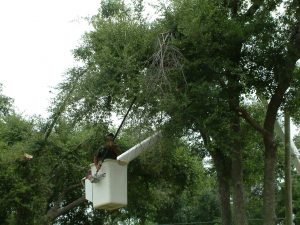
Professional arborists have specialized training to create safe, structurally sound trees, even when damaged by storms. Photo by Beth Bolles, UF IFAS Extension Escambia County
Certified arborists go through a voluntary certification process with the International Society of Arboriculture which means that they have at least three years experience and have passed a comprehensive examination developed by tree experts. A certified arborist maintains certification by attending regular training courses.
An arborist may also be a member of another organization which helps professionals stay up-to-date on tree care techniques and information. These include the National Arborist Association and the American Society of Consulting Arborists.
Hiring an arborist to work on your trees is important for several reasons. An arborist can evaluate the tree and determine the steps necessary to create a healthy specimen. In regards to pruning, the professional will determine what type of pruning is necessary and remove branches properly.
Professionals will also perform tree care practices that are recommended by University research. A few practices that the arborist would not perform include topping trees, using climbing spikes on trees which are not being removed, and making flush cuts against the trunk.
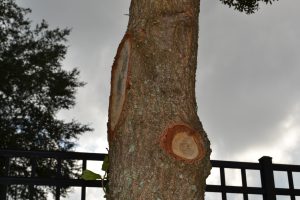
Flush cuts are damaging to trees and can create a future hazard in your landscape. Photo by Beth Bolles, UF IFAS Extension Escambia County
Finally arborists have the skills and equipment to safely and efficiently prune or remove trees. This includes personal and property damage insurance and workers compensation insurance.
Next time you need tree work or advice, hire a professional for the job. It will definitely be worth the investment.
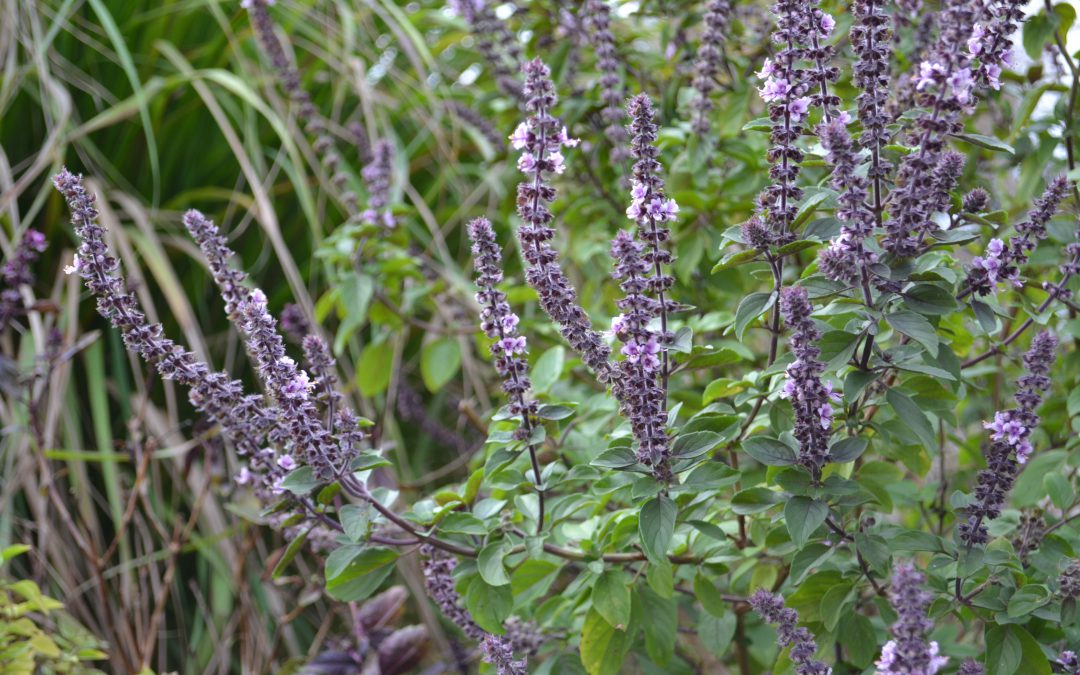
by Beth Bolles | Jul 5, 2017
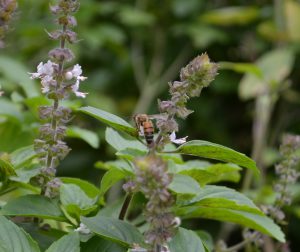
Many bees and beneficial wasps will be attracted to African blue basil. Photo by Beth Bolles, UF IFAS Extension Escambia County
Basil is a favorite plant in the summer herb garden and an absolute must for those who enjoy fresh leaves for a sandwich or delicious homemade pesto. While we grow basils as a food enhancer, an added benefit is that those basil selections that form flowers are very attractive to pollinators. If you would rather not let your favorite basil form flowers, consider adding a specific species that is grown more for its attractiveness to pollinators than its culinary uses.
African blue basil is a hybrid of two basils that has inherited a camphor flavor from one of its parents. Although edible, the flavor may not be appealing to those who are familiar with more traditional basil flavors. Plants produce abundant flowers that are pink with a dark purple base, although flowers are sterile so no seeds will be formed. If you want more African blue basil, you must purchase transplants or start your own from cuttings off the main plants.
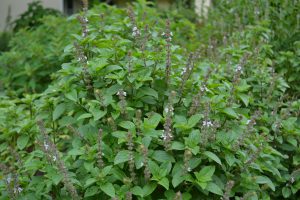
African blue basil enhances gardens and landscapes. Photo by Beth Bolles, UF IFAS Extension Escambia County
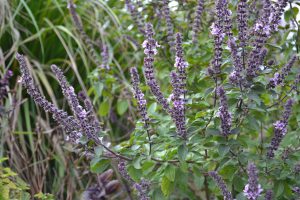
Flowers of African blue basil are also showy in the garden. Photo by Beth Bolles, UF IFAS Extension Escambia County
Like other basils, African blue basil does like soils amended with composts that are well-drained. Plants thrive in full sun and will form rounded mounds that will be much larger than more culinary basils, up to five feet in some gardens. Plants do form woody stems and although frost tender, some plants may return in the spring in more protected areas.
Although some edible gardeners may not want to allow space for a basil that they will not use in the kitchen, the amount of pollinator activity on this selection makes it a benefit to any edible garden for all the frost-free months.
by Beth Bolles | Jun 10, 2017
It is common in Northwest Florida for palms to show signs of nutrient deficiencies. In general our sandy soil is often nutrient poor and available nutrients can easily move out of soils with frequent rainfall. In landscapes where fertilization is occurring, often the wrong types of fertilizer are applied. Fertilizer miss-application actually increases nutrient problems for the palm.
Palms can be deficient in many nutrients but the most common deficiencies we see in landscapes are from inadequate amounts potassium and magnesium. The simple solution would be to purchase a fertilizer labeled for palms to correct the problem. The difficulty is that most easily available fertilizers for palms do not have the correct form of nutrients that are required for the problems. With the exception of nitrogen, all other nutrients are in a quick release form so while the slow release nitrogen lasts for 2-3 months, all other nutrients have been used up. In response, the palm is encouraged to grow by the nitrogen but does not have enough of the other critical nutrients to carry out vital plant functions. What we see is often older leaves that are yellowing, browning, and die off before they should because the plant is pulling any available potassium and magnesium from old fronds to support new growth. Without the application of proper nutrients to the soil, the deficiency can continue until even new fronds are affected or the palm dies.
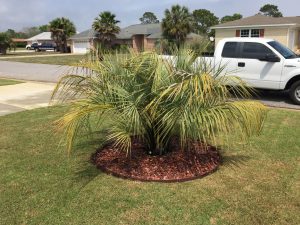
The fertilizer used for lawns does not have all the slow release and correct forms of nutrients for the palms. Older leaves turn yellow and brown indicating potassium deficiency. Photo by Beth Bolles, UF IFAS Extension Escambia County.
There is a solution that will help keep your palms healthy and attractive. Make sure you choose a specially designed fertilizer that has all nutrients in slow release form. Look for an analysis such as 8-2-12-4 (Nitrogen-Phosphorus-Potassium-Magnesium). Also read further on the label for Polymer Coated Sulfate of Potash, Magnesium Sulfate (Kieserite), and Chelate (Iron EDTA). These are the forms of nutrients that will be beneficial to your palms.
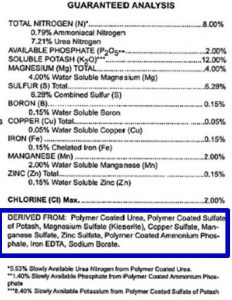
Look in the area ‘Derived From’ (outlined in blue) on your fertilizer label to find the forms of nutrients. Photo by Dr. Monica Elliott, US/IFAS Extension.
If you have a mixed landscape where the palms are planted in the lawn, be sure to keep all lawn fertilizers out of the root zone of the palms. Lawn fertilizers do not have the correct forms of nutrients for palms. Remember also that palms roots extend many feet beyond the palm canopy so your ‘no lawn fertilizer zone’ may be past the mulch ring.
The recommendation from the University of Florida is 1.5 pounds of fertilizer over a 100 square foot area. Broadcast this on top of the ground and lightly water after application. In North Florida, you will likely apply the correct palm fertilizer about at least two times in May and end of August or 1st of September. If you are not able to use a palm fertilizer with the correct form of slow release nutrients, it is best not to fertilize palms at all.
by Beth Bolles | May 1, 2017
We may shy away from drama in our lives but drama in the garden is always welcome. One plant series that will be a prominent feature in any garden bed is the Amazon Dianthus series.
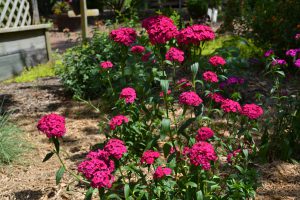
Amazon Dianthus series is showy in the garden or in a container. Photo by Beth Bolles, UF IFAS Extension Escambia County
Although we normally consider Fall the time to plant dianthus, the Amazon Series developed by PanAmerican Seed company can be planted in Spring for blooms that extend into Summer. This is the combination of two dianthus and the results are plants with striking colors and longer blooming cycles.
The Amazon series comes in a few bright colors including Amazon Neon Cherry, Amazon Neon Pink, and Amazon Rose Magic. Flowers are held on stems about 1.5-2′ tall and foliage is an attractive dark green. Plants are generally low maintenance but be sure to deadhead flowers as they fade. Plants will need rich, well drained soil and full sun.
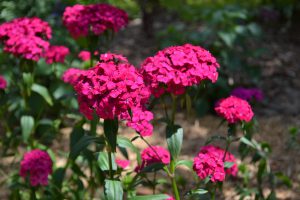
Neon Cherry. Photo by Beth Bolles, UF IFAS Extension Escambia County
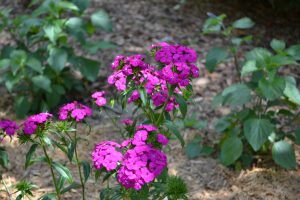
Neon Pink. Photo by Beth Bolles, UF IFAS Extension Escambia County
If you don’t have room for the Amazon dianthus series in your landscape, plants will also grow well in containers to brighten a patio or deck.
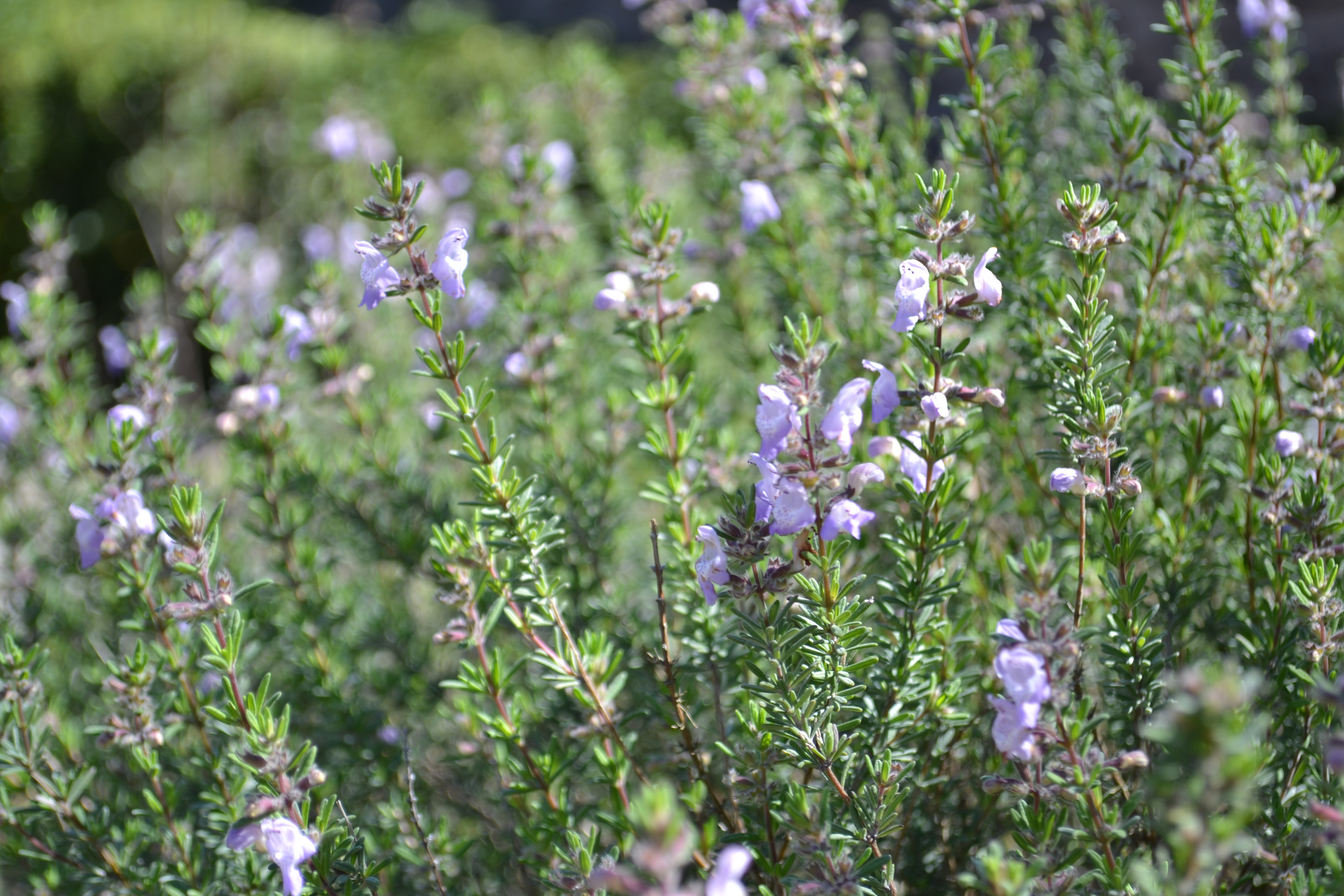
by Beth Bolles | Mar 30, 2017
We often talk about sandy, nutrient poor soil in Florida and how difficult it is for growing many favorite landscape plants. Gardeners may spend considerable time and money amending soils with organic matter to improve quality.
The low maintenance approach is to embrace your sandy soil and consider plants that thrive in sandy, well-drained soil. One very attractive native shrub that actually prefers this type of soil is false rosemary, Conrandina canescens.
False rosemary is a member of the mint family that is well adapted to drier, sandy soils. It can be found in many coastal communities growing in natural areas. It is easily recognized in the spring and early summer by light purple blooms. Considered a small shrub or groundcover, False rosemary needs full sun. One plant can easily spread out to 4-5 feet in diameter with a height of 2-3 feet.
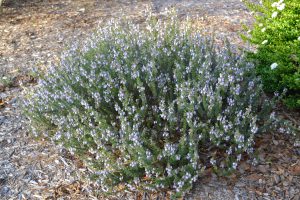
False rosemary is an attractive native plant for Gulf Coast landscapes. Photo by Beth Bolles, UF Escambia County Extension
False rosemary does have aromatic foliage and is attractive to bees. It is a very low maintenance plant once established and its few issues tend to be related to soils with too much moisture and plants being shaded after establishment. New seedlings will emerge around the main plant when growing conditions are right. If you want to try this native plant in your landscape, talk to a local nursery.
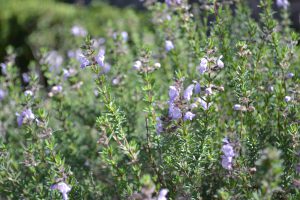
False rosemary flowers are attractive to pollinators. Photo by Beth Bolles, UF Escambia County Extension














